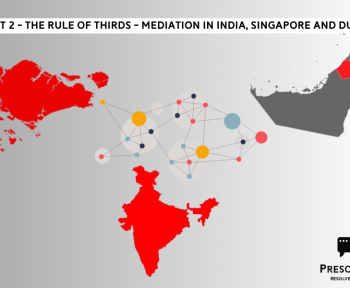It is well established that people don’t leave bad organizations, they leave bad managers and bad teams!
Employee attrition take spot in the top 5 things that keeps CXOs awake, not only in India but also globally. Here’s an opportunity to turn this around – thanks to the magic of the ‘M’ word. Bad work environments or workplace disputes can arise from various issues, like:
- disagreements over wages,
- working conditions,
- labour policies,
- interpersonal conflicts like sexual harassment, bullying, discrimination, or,
- ineffective leadership.
These disputes not only impact team dynamics and employee well-being but can also lead to significant organizational disruptions. This may often lead to drastic measures such as:
- strikes,
- lockouts, or,
- high employee turnover.
Additionally, post-resignation disputes over unpaid wages, bonuses, or unauthorized use of intellectual property by departing employees are also common. This article explores the importance of the magic word, ‘mediation’, in resolving these disputes.
Mediation at workplace:
Workplace disputes are an inevitable part of any company, arising from differences in opinions, goals, or interpersonal conflicts among employees. These disputes, if not managed effectively, can lead to a toxic work environment, reduced productivity, and high employee turnover. Mediation offers a constructive and effective approach to resolving workplace disputes by facilitating open communication and mutual understanding between conflicting parties. This method emphasizes collaboration and finding mutually acceptable solutions, making it a valuable tool for maintaining a harmonious workplace.
Mediation involves a neutral third party, known as the mediator, who helps the disputing parties communicate their concerns and explore potential solutions. Unlike traditional disciplinary measures or litigation, mediation is informal, voluntary, and confidential, which encourages honest and open dialogue. The mediator does not impose a decision but instead guides the parties towards finding their own resolution. This participatory approach ensures that the solutions are tailored to the specific needs and interests of the parties involved, leading to higher satisfaction and long-lasting agreements.
Workplace disputes are people-centric, making mediation an ideal resolution method due to its collaborative, flexible, and confidential nature. Mediation encourages dialogue, promotes understanding, and helps rebuild trust amongst employees and between employees and management. It is non-adversarial, preventing conflicts from escalating, reducing stress, and promoting cooperation. The confidentiality of the process ensures privacy, fostering trust and enabling parties to explore solutions freely, even in highly sensitive matters.
Its focus on future relationships encourages preventative measures and proactive conflict resolution. Participation is voluntary, ensuring all parties are committed to finding solutions. Its effectiveness lies in empowering parties, preserving relationships, and fostering communication, ultimately leading to mutually acceptable and sustainable resolutions.
People leave managers, not companies:
According to a report by The Myers-Briggs Company, managers spend an average of 4 hours a week dealing with conflict, and 25% of employees believe their managers handle conflict poorly. This highlights the need for improved conflict management training not only for HR professionals but also for the entire workforce. Identifying early signs of conflict in the workplace is crucial for maintaining a productive and harmonious environment. Mediation training can equip leaders as well as team members with the skills to recognize these signs and address them proactively.
Here’s how such training can benefit every team member, and, ultimately, the organization:
1. Identifying early signs of conflict: Some common indicators of workplace conflict include dysfunctional meetings, characterized by frequent arguments and lack of clear outcomes, often signal underlying tensions among team members. Additionally, a noticeable decline in productivity and participation can indicate that unresolved conflicts are distracting employees and diminishing their motivation. Excessive absenteeism, where employees frequently and inexplicably miss work, may suggest they are avoiding the workplace due to stress or discomfort from interpersonal conflicts. Communication gaps, such as breakdowns in information sharing or avoidance of dialogue, typically point to trust issues within the team. Loss of trust further manifests as decreased cooperation and reluctance to share ideas, fostering a hostile work atmosphere. Finally, a high rate of employee resignation usually reflects deep-seated conflicts and dissatisfaction, prompting employees to seek more harmonious work environments elsewhere. Recognizing these signs early can help address and resolve conflicts before they escalate.
2. Effective Dispute Resolution: Equipping HR professionals with conflict management and mediation skills enables them to address workplace disputes promptly and effectively. They can act as impartial mediators, facilitating constructive dialogues between conflicting parties and guiding them towards mutually acceptable resolutions.
3. Reduced Burden: With proper training, teams can handle conflicts with confidence and competence, reducing the burden on themselves and the organization. Rather than relying solely on external resources or escalating conflicts to higher levels, they can manage many issues internally, saving time and resources.
4. Strategic Approach: Training provides HR professionals with a structured approach to conflict resolution. They learn to analyse the root causes of conflicts, develop action plans, and implement appropriate interventions. This strategic approach helps prevent recurring conflicts and promotes long-term organizational stability.
5. Enhanced Communication Skills: Conflict management and mediation training emphasize active listening, effective communication, and empathy-building techniques. These skills enable HR professionals to foster open communication channels, build trust with employees, and address underlying concerns proactively.
6. Empowerment of Employees: By facilitating mediation sessions and providing conflict resolution support, HR professionals empower employees to resolve their differences constructively. This approach promotes employee engagement, strengthens interpersonal relationships, and fosters a positive work culture.
7. Cultural Sensitivity: Conflict management and mediation training often include modules on cultural differences. HR professionals learn to navigate diverse workplace dynamics sensitively, respecting cultural differences and promoting inclusivity.
Conclusion: The Strategic Role of HR in Promoting Workplace Harmony Through Mediation
HR professionals play a pivotal role in cultivating a harmonious and productive workplace culture, and mediation training is essential in this endeavour. Such training equips HR managers as well as the team members with the skills to identify and address early signs of conflict and enables them to impart these crucial skills to managers across all departments. By fostering a comprehensive understanding of conflict management throughout the organization, HR managers can significantly enhance employee cooperation and engagement.
Mediation is becoming the preferred method for resolving workplace disputes due to its facilitative and non-adversarial approach. The advent of e-mediation has further streamlined this process. E-mediation modules, such as those offered by Presolv360, provide convenient and flexible dispute resolution, accessible from any location and at any time, eliminating geographical barriers. Conducted online from participants homes, they reduce intimidation and promote comfort. Seamless integration with HRMS systems ensures streamlined processes, while maintaining confidentiality. These modules adhere to strict security and data protection measures, guaranteeing a secure environment for resolving disputes efficiently and effectively.
By embracing mediation and leveraging the advantages of e-mediation, HR leaders can lead the way in establishing a more harmonious and productive workplace culture. This proactive approach not only addresses conflicts effectively but also builds a resilient organizational culture that can adapt to future challenges.




